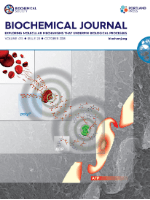
CELL BIOCHEMISTRY AND FUNCTION
Scope & Guideline
Exploring the Intricacies of Biochemical Functionality
Introduction
Aims and Scopes
- Cancer Biology and Therapeutics:
The journal frequently publishes studies that investigate the biochemical pathways involved in cancer progression and therapy, including targeted therapies, chemoresistance, and the role of non-coding RNAs. - Metabolic Disorders and Diabetes:
Research exploring the biochemical underpinnings of metabolic disorders, particularly diabetes mellitus, is a core area, with a focus on insulin signaling, cellular metabolism, and therapeutic interventions. - Stem Cell Biology and Regenerative Medicine:
The journal highlights advancements in stem cell research, including the therapeutic potential of mesenchymal stem cells and their derivatives, and the mechanisms through which they promote tissue regeneration. - Neurobiology and Neurological Disorders:
Studies on cellular mechanisms in neurological diseases, including the role of oxidative stress, inflammation, and cellular signaling pathways in neurodegeneration, are prominent. - Immunology and Inflammation:
Research addressing the biochemical aspects of immune response and inflammation is a significant focus, particularly in the context of autoimmune diseases and cancer. - Nanotechnology and Drug Delivery Systems:
The journal explores innovative drug delivery systems, including nanoparticle-based approaches, to enhance therapeutic efficacy and reduce side effects in various diseases. - Microbial and Plant-Derived Therapeutics:
Investigations of bioactive compounds from plants and microbes, their mechanisms of action, and their potential therapeutic applications are regularly featured.
Trending and Emerging
- Biochemical Mechanisms of Cancer Immunotherapy:
A surge in research examining the biochemical pathways involved in cancer immunotherapy, including immune checkpoint inhibitors and the role of the tumor microenvironment, is evident. - Role of Non-Coding RNAs in Disease Mechanisms:
There is an increasing focus on the role of long non-coding RNAs and microRNAs in regulating cellular processes related to cancer, metabolic disorders, and other diseases. - Metabolomics and Systems Biology:
Studies employing metabolomics to explore systemic biochemical changes in diseases are becoming more prevalent, reflecting an interest in holistic approaches to understanding health and disease. - Targeted and Personalized Medicine Approaches:
Research emphasizing personalized medicine, particularly in cancer treatment, through targeted therapies based on individual biochemical profiles is on the rise. - Microbiome Research in Health and Disease:
The influence of the microbiome on human health and disease, including its biochemical interactions with host metabolism and immunity, is emerging as a significant research area. - Regenerative Medicine and Tissue Engineering:
Advancements in regenerative medicine and tissue engineering, particularly related to stem cell therapies and bioengineering approaches for tissue repair, are increasingly featured.
Declining or Waning
- Traditional Pharmacology:
There is a noticeable decrease in studies focused solely on traditional pharmacological approaches without integrating modern biochemistry or molecular biology techniques. - Basic Cellular Mechanisms without Disease Context:
Research that purely investigates basic cellular mechanisms, without linking findings to specific diseases or therapeutic applications, has become less frequent. - Animal Models with Limited Relevance to Human Disease:
The use of animal models that do not adequately mimic human diseases or conditions has declined, as there is a growing preference for more relevant models that can provide insights applicable to human health. - Single-Cell Studies without Comprehensive Analysis:
While single-cell studies are gaining traction, there is a waning interest in studies that do not employ comprehensive analyses, such as integrating multi-omics approaches. - In Vitro Studies without Clinical Correlation:
Research focusing solely on in vitro experiments without correlating findings to clinical implications or outcomes has seen a decline, as there is an increasing demand for translational research.
Similar Journals

CELL BIOCHEMISTRY AND BIOPHYSICS
Connecting Biochemistry, Biophysics, and Cell BiologyCELL BIOCHEMISTRY AND BIOPHYSICS is a distinguished journal published by HUMANA PRESS INC, focusing on critical advancements in the fields of biochemistry, biophysics, and cell biology. Since its establishment, the journal has provided a robust platform for the dissemination of cutting-edge research, covering diverse aspects of cellular biochemistry and the physical principles that underlie biological systems. With an emphasis on interdisciplinary studies, the journal aims to facilitate knowledge exchange among researchers, professionals, and students from various scientific backgrounds. As reflected in its 2023 category rankings, it holds a respectable position in Q3 for Biochemistry and Cell Biology, and Q2 for both Biophysics and Medicine (miscellaneous), indicating its significant contribution to these fields. Although it operates under a subscription model, the journal's commitment to maintaining high publication standards ensures that only impactful studies are shared with its audience. With a range of articles spanning theoretical insights to practical applications, CELL BIOCHEMISTRY AND BIOPHYSICS is an essential resource for those aiming to stay at the forefront of biochemical and biophysical research.

Biochemistry and Biophysics Reports
Unlocking the mysteries of biochemistry and biophysics.Biochemistry and Biophysics Reports, published by Elsevier, serves as a vital platform for the dissemination of innovative research in the fields of biochemistry, biophysics, cell biology, and molecular biology. With an Open Access model initiated in 2015, this journal aims to facilitate the unimpeded sharing of knowledge, allowing researchers, professionals, and students free access to significant findings and developments. The journal has established a presence in the academic community, currently holding a Q3 ranking in Biochemistry, Q2 in Biophysics, alongside its Q3 standings in both Cell Biology and Molecular Biology categories for 2023. These metrics underscore its commitment to quality and relevance, garnering attention with Scopus ranks reflecting its emerging influence. Located in the Netherlands, Biochemistry and Biophysics Reports continues to foster dialogue and collaboration among the scientific community through high-quality research outputs, contributing to advancements in understanding the intricate biochemical processes and biophysical principles that underpin life sciences.

Cell Reports
Connecting Scientists to Transformative DiscoveriesCell Reports is a prestigious open-access journal published by CELL PRESS that has firmly established itself as a leading voice in the fields of Biochemistry, Genetics, and Molecular Biology. Since its inception in 2012, the journal has provided an innovative platform for rapid dissemination of cutting-edge research, ensuring that high-quality findings are accessible to a global audience. With an impressive impact factor and ranking within the top 10% in its category, as reflected by its Q1 ranking in Scopus, Cell Reports serves a vital role in advancing scientific knowledge and fostering collaboration among researchers. The journal's commitment to the open-access model not only enhances visibility but also encourages the sharing of critical advancements in molecular biology. Situated in the Netherlands, its contributions are recognized worldwide, making Cell Reports an indispensable resource for scientists aiming to stay at the forefront of their fields and facilitate breakthroughs that may shape the future of biomedicine.

CELLULAR AND MOLECULAR LIFE SCIENCES
Empowering Global Collaboration in Life Sciences ResearchCELLULAR AND MOLECULAR LIFE SCIENCES, published by SPRINGER BASEL AG, stands as a premier journal dedicated to advancing the field of cellular and molecular biology. With an impressive 2023 impact factor reflected in its Q1 rankings across key categories—including Cell Biology, Molecular Biology, and Pharmacology—it serves as a critical platform for researchers aiming to disseminate high-quality findings in these dynamic fields. Operated under an open access framework, the journal allows broader accessibility to groundbreaking research, fostering collaboration amongst scientists globally. Based in Switzerland, CELLULAR AND MOLECULAR LIFE SCIENCES has been at the forefront of scientific publishing since 1952, adapting to contemporary scientific challenges and trends, ultimately shaping the future of life sciences.

BIOCHEMICAL JOURNAL
Illuminating the Path of Molecular DiscoveryBIOCHEMICAL JOURNAL, published by Portland Press Ltd, stands as a leading publication in the fields of Biochemistry, Cell Biology, and Molecular Biology, reflecting a commitment to advancing scientific knowledge since its inception in 1945. With a distinguished Q1 ranking across these categories and impressive Scopus rankings, the journal serves as an invaluable resource for researchers, professionals, and students alike, facilitating critical discoveries and innovative research practices. Although not currently offering open access, the journal provides a platform for high-quality peer-reviewed articles, ensuring rigorous standards in the dissemination of biochemical research. Spanning over seven decades and continuing through to 2024, the BIOCHEMICAL JOURNAL fosters an environment where cutting-edge biochemical research thrives, supporting the global scientific community's efforts to address complex biological questions and enhance our understanding of fundamental cellular processes.

BIOSCIENCE REPORTS
Advancing the Frontiers of Life SciencesBIOSCIENCE REPORTS, published by Portland Press Ltd, is a prestigious journal dedicated to advancing the fields of biochemistry, biophysics, cell biology, and molecular biology. Founded in 1981, the journal has established itself as a vital resource for researchers and professionals, boasting a significant impact factor and high rankings within its categories, including Q2 in Biochemistry and Q1 in Biophysics as of 2023. The journal’s commitment to high-quality, peer-reviewed research ensures that it remains an influential platform for the dissemination of cutting-edge scientific findings. While it operates under a traditional subscription model, it offers various access options to accommodate the needs of the scientific community. With ongoing publication through 2024, BIOSCIENCE REPORTS continues to play a crucial role in shaping discussions in the life sciences and fostering innovative research in biology.

Biochemistry and Cell Biology
Exploring the intricate dance of biochemistry and cellular mechanisms.Biochemistry and Cell Biology, published by Canadian Science Publishing, is a prestigious journal that has been instrumental in advancing the fields of biochemistry, molecular biology, and cell biology since its inception in 1986. With an impressive scope spanning innovative research findings to comprehensive reviews, this journal serves as a vital resource for researchers, professionals, and students alike. Currently positioned in the Q2 quartile in Biochemistry and Q3 quartiles in both Cell Biology and Molecular Biology, it reflects a robust contribution to scientific discourse, placing it among reputable publications in its field. The journal boasts notable rankings within the Scopus database, highlighting its impact and relevance, and continues to be a valuable platform for disseminating pivotal research. By providing access to a wide array of articles, the journal remains committed to fostering knowledge and collaboration in the scientific community.

BMB Reports
Connecting Minds, Transforming MedicineBMB Reports is a distinguished open-access journal published by the Korean Society of Biochemistry & Molecular Biology since 2008, making significant contributions to the fields of biochemistry, molecular biology, and medicine. With a current impact factor that positions it in the Q2 category for Biochemistry and Q1 for Miscellaneous Medicine, this journal supports a wide dissemination of high-quality research findings, fostering robust dialogue among researchers, professionals, and students alike. Based in Seoul, South Korea, BMB Reports aims to publish innovative studies that advance our understanding of biochemical and molecular processes, thus shaping the future of health and medicine. The journal's commitment to open access enhances the visibility of its articles, allowing for greater accessibility and engagement in the scientific community. With notable rankings in both the Biochemistry and Molecular Biology categories, BMB Reports stands as a vital resource for those seeking to stay at the forefront of research in these rapidly evolving disciplines.

NEUROCHEMISTRY INTERNATIONAL
Pioneering Discoveries in Neurochemistry and HealthNEUROCHEMISTRY INTERNATIONAL, published by Pergamon-Elsevier Science Ltd, offers a premier platform for researchers and professionals in the realms of cell biology and cellular and molecular neuroscience. Established in 1980 and continuing its passion for advancing the field, this esteemed journal enhances scientific collaboration with a notable 2023 Q2 ranking in both relevant categories, placing it among the top-tier publications in its discipline with a Scopus rank of 23/97 for Cellular and Molecular Neuroscience. With its focus on groundbreaking research, the journal provides a wealth of vital data and insights that drive forward our understanding of neurochemistry and its implications in health and disease. While not an Open Access journal, NEUROCHEMISTRY INTERNATIONAL is integral for professionals, academics, and students aiming to stay at the forefront of neurobiological research innovations, making significant contributions to both academia and clinical applications.

FEBS Journal
Elevating Scientific Discourse in BiosciencesFEBS Journal is a prestigious, peer-reviewed publication dedicated to advancing the field of biochemistry, cell biology, and molecular biology. Published by WILEY in the United Kingdom, this journal boasts an impressive impact factor and ranks in the top quartile (Q1) across multiple relevant categories, including Biochemistry, Cell Biology, and Molecular Biology, reflecting its significant contribution to scientific research. With an ISSN of 1742-464X and an E-ISSN of 1742-4658, the FEBS Journal publishes original research and comprehensive reviews that push the boundaries of knowledge and innovation in the biosciences. As a vital resource for researchers, professionals, and students alike, the journal offers Open Access options, ensuring that cutting-edge discoveries are accessible to a broad audience. With a publication history converging from 2005 to the present and a robust emphasis on high-quality scholarly work, the FEBS Journal remains an essential platform for the dissemination of significant findings and advancements in the life sciences.